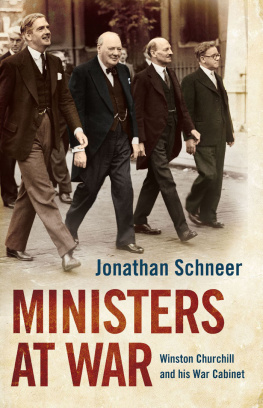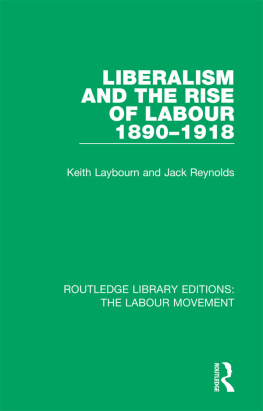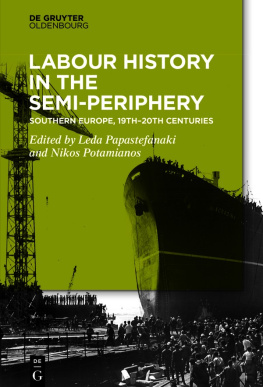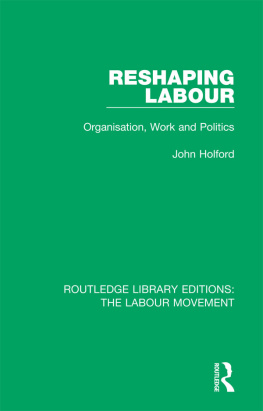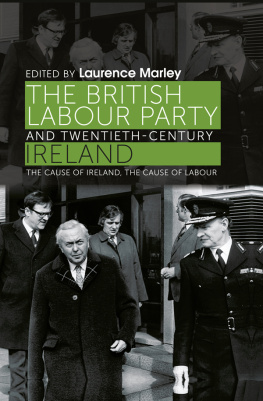ROUTLEDGE LIBRARY EDITIONS:
THE LABOUR MOVEMENT
Volume 29
BEN TILLETT
BEN TILLETT
Portrait of a Labour Leader
JONATHAN SCHNEER
First published in 1982 by Croom Helm Ltd
This edition first published in 2019
by Routledge
2 Park Square, Milton Park, Abingdon, Oxon OX 14 4RN
and by Routledge
711 Third Avenue, New York, NY 10017
Routledge is an imprint of the Taylor & Francis Group, an informa business
1982 Jonathan Schneer
All rights reserved. No part of this book may be reprinted or reproduced or utilised in any form or by any electronic, mechanical, or other means, now known or hereafter invented, including photocopying and recording, or in any information storage or retrieval system, without permission in writing from the publishers.
Trademark notice: Product or corporate names may be trademarks or registered trademarks, and are used only for identification and explanation without intent to infringe.
British Library Cataloguing in Publication Data
A catalogue record for this book is available from the British Library
ISBN: 978-1-138-32435-0 (Set)
ISBN: 978-0-429-43443-3 (Set) (ebk)
ISBN: 978-1-138-33169-3 (Volume 29) (hbk)
ISBN: 978-0-429-44713-6 (Volume 29) (ebk)
Publishers Note
The publisher has gone to great lengths to ensure the quality of this reprint but points out that some imperfections in the original copies may be apparent.
Disclaimer
The publisher has made every effort to trace copyright holders and would welcome correspondence from those they have been unable to trace.
Ben Tillett
Portrait of a Labour Leader
Jonathan Schneer
CROOM HELM
London & Canberra
CONTENTS
1982 Jonathan Schneer
Croom Helm Ltd, Provident House, Burrell Row,
Beckenham, Kent BR3 1AT
British Library Cataloguing in Publication Data
Schneer, Jonathan
Ben Tillett.
1. Tillett, Ben 2. Trade-unions Great
Britain Biography
I. Title
331.880924 HD6665.T/
ISBN 0-7099-2341-4
Printed and bound in Great Britain by
Billing and Sons Limited Worcester
The public performance of Ben Tillett is a subject which any modern British historian might examine easily enough. The numerous organizations, committees and public bodies on which he served usually left printed records of their proceedings. The political campaigns and strikes in which he participated were reported almost always in the press. Tillett himself wrote numerous pamphlets and articles explaining where he stood on questions of the day. But his private circumstances are not so readily accessible to researchers. A small Ben Tillett Collection at the Modern Records Centre, Warwick University, casts almost no light upon them. Tilletts daughter, Mrs Jeanette Davis, who died in 1976, knew little about her fathers early years, and preferred not to discuss life in the Tillett household. Frank Stillwell, Tilletts son-in-law (he had married a second daughter), also died in 1976 before I could speak to him. Consequently, Ben Tillett: Portrait of a Labour Leader inevitably focuses upon Tilletts public career, which extended from 18871921. It is not intended to be a full-length biography, though I have dealt briefly with his early and late years.
Many people helped in the preparation of this manuscript. I would like particularly to acknowledge my profound debt to Professor Stephen Koss, of Columbia University, who supervised my research while I was his student, and who encouraged me with friendly criticism and suggestions at later stages of the project. Professor Robert Paxton, Professor Peter Weiler, Professor James Cronin, Professor Eugene Black, Professor Peter Stansky, Professor David Montgomery, Professor Standish Meachum and Mr John Grigg also read portions of the manuscript and offered sound advice. In addition, I owe thanks to Janet Druker and Richard Storey of the Modern Records Centre at Warwick University for directing me to much useful material, to Professor John Saville of Hull University who generously opened the files of the Dictionary of Labour Biography to me, and to David Barlowe, former research librarian of the Transport and General Workers Union. To librarians, archivists and friends too numerous to list, I offer thanks as well.
On a blustery evening in early March 1976, Lord George-Brown emerged suddenly from the Palace of Westminster to announce his resignation from the Labour Party. He had become increasingly disenchanted with the Labour establishment, the former Labour Cabinet Minister said, because it no longer cared about individual freedom.
In the rambling talk with which he accompanied his statement of resignation, Lord George-Brown emphasized that he did not easily make the break with Labour. He had been affiliated with the labour movement since the beginning of his career. His father had been one of its pioneers. My dear old dad joined the Dockers Union in 1898; his membership card was signed by Ben Tillett. Then Lord George-Brown, who perhaps had had too much to drink, fell down. Tillett, who on one occasion had to be led to the TUC rostrum because he could not find it himself, would have sympathized.
The invocation of Tillett was appropriate in another respect. Like Lord George-Brown, Tillett was a man with a talent for plain speaking which often generated more antagonism than anything else. He was less at home with the politicians than with the trade unionists in the Labour Party. Above all else, he was labours stormy petrel, a title which early in his career he proudly advertised, but which later he wished to renounce. And, as with Lord George-Brown, that proved to be impossible. Tillett was a weathercock during the heroic age of British labour history; where he pointed others were sure to follow, and that usually meant rough weather ahead.
The man capable of inspiring Lord George-Browns admiration had other considerable achievements to his credit. Ben Tillett helped to lead the great London dock strike of 1889 and to found the Dock, Wharf, Riverside and General Labourers Union of Great Britain and Ireland, of which he was general secretary until 1922, when it was transformed into the modern Transport and General Workers Union. A prominent new unionist during the late 1880s and early 1890s, he was no less notable during the great unrest of 191014 as a direct actionist. He played a significant role in nearly all the industrial disputes affecting British dockers between 1889 and 1921. At the annual meetings of the Trades Union Congress (TUC), as a member of its parliamentary committee between 1892 and 1895, as the leader of one of Englands largest unions of unskilled labourers, and as co-founder of the National Transport Workers Federation and the Triple Alliance which contained the National Transport Workers Federation, miners and railwaymens unions, Tillett proved himself a formidable figure in the trade union world. Simultaneously he was carving a niche in the political side of the working-class movement. He was a founder of the Independent Labour Party in 1893 and a member of its executive council during the following year. In 1900 he helped to establish the Labour Representation Committee (direct ancestor of the Labour Party) and served for a year on its executive council as well. He stood unsuccessfully for Parliament in 1892, 1895, 1906 and 1910, gaining national attention during the first and last of these contests. In 1917, during the First World War (which he vehemently supported), he finally gained entrance to the House of Commons as the Labour Member from North Salford, which he continued to represent until 1924, and then again from 192931. He was deeply involved in most of the important developments affecting the modern working class during its formative period.


